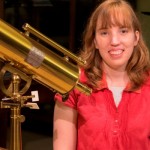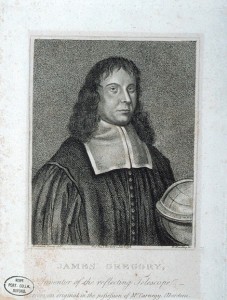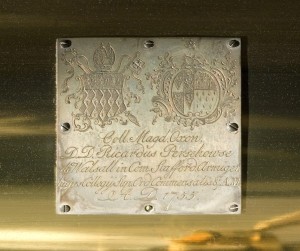 Gregorian Telescope – Inventory no. 90369
Gregorian Telescope – Inventory no. 90369
Lynn Atkins – MSc student in history of science
There are primarily two types of telescopes, one being a reflecting telescope. The other type of telescope, the refracting telescope, at first was more popular with astronomers and natural philosophers because no one had successfully made a reflecting telescope.
A reflecting telescope?

James Gregory
It was not until the seventeenth century that James Gregory, a Scottish mathematician and astronomer, as able to design a working reflecting telescope, a design that becomes known as the Gregorian reflecting telescope. James Gregory was a mathematics professor at the University of St.Andrews and then the University of Edinburgh. Along with designing a successful reflecting telescope Gregory made contributions to calculus and was held in high regards by some. Gregory describes his reflecting telescope design in his book Optica Promota which was published in 1663.
However, Gregory did not have the skills to make the telescope himself, specifically the concave mirrors needed. Robert Hooke at the Royal Society read Gregory’s book and ten years later decided to help Gregory build his telescope. Isaac Newton had built is own reflecting telescope five years earlier in 1668. James Short, coincidentally also a Scottish mathematician, made this Gregorian telescope. On top of being a telescope maker and mathematician he was an optician which was important because that allowed him to make not only lenses but mirrors.
His main profession was as a telescope maker. Short’s first shop was in Edinburgh, but he eventually left for London and set up practice there. He moved to London because he was summoned by Queen Caroline to tutor her second son, William Augustus, in mathematics.
Short began his telescope making using James Gregory’s suggestions, but over time he made changes and improvements. His telescopes were widely distributed and known. In 1752, he completed a Gregorian telescope for the king of Spain. In addition to his telescope improvements, he made observations and constructed original instruments.
How does a Gregorian telescope work?
 A Gregorian telescope is made up of two concave mirrors to magnify the object. The mirrors are mounted inside a brass barrel which is on a stand to add stability. More elaborate Gregorian telescopes like this one also have small telescopes attached to the main barrel to help align the telescope with the object.
A Gregorian telescope is made up of two concave mirrors to magnify the object. The mirrors are mounted inside a brass barrel which is on a stand to add stability. More elaborate Gregorian telescopes like this one also have small telescopes attached to the main barrel to help align the telescope with the object.
How it works is that light from a distant object enters the telescope and travels down to the larger primary mirror at the bottom of the barrel. The primary mirror reflects the light back up towards a smaller secondary mirror located some way up the barrel, which in turn reflects the light back down through a small aperture in the primary mirror where it is then brought into focus by the eyepiece lens. Beside the eyepiece there is a knob which focuses the telescope by adjusting the distances between the mirrors.
Download a PDF of this text here.
